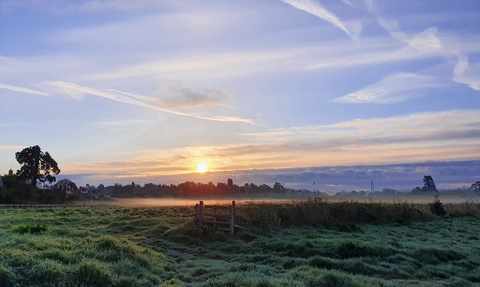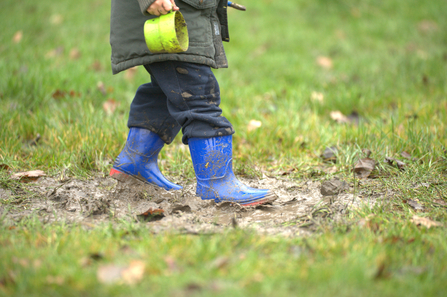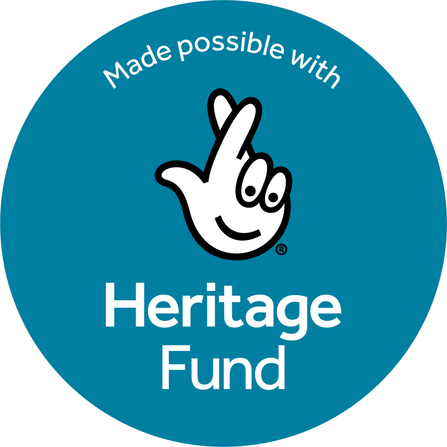
School visits to Bartonsham Meadows
As part of our ‘Restoring Bartonsham Meadows’ project, funded by the National Lottery Heritage Fund we are delivering a new range of learning programmes for schools within Hereford.
Previously used for cattle grazing and arable crops, we plan to restore part of the site, which is regularly inundated by the River Wye, to be species-rich, floodplain meadows. The remainder of the site will be managed to allow natural processes which, over time will create a patchwork of grassland and scrub which will be a fantastic habitat for all kinds of wildlife.
Sessions can take place on the Meadows, within school or as part of an after school club. All sessions are free of charge.
More information on what we deliver can be found below. For any more information, or to book please contact Jenny Mottershead, Bartonsham Community Officer - j.mottershead@herefordshirewt.co.uk or 07377525916
Early Years Foundation
All our sessions promote the overarching principles of Early Years Statutory Framework and support many of the Learning and Development Requirements. Activities particularly help develop communication and language skills, personal, social and emotional development and an understanding of the world.
We offer a choice of 3 topics; each is 2 hours long however we can adapt the session to be slightly longer or shorter if needed. Visits can take place all year, although minibeasts and plants would be best between April – October.
Minibeasts
Children will investigate mini beasts from different habitats using a variety of methods, such as sweep netting, pitfall traps and tree beating. The class will also learn how to identify what they have found and have a think about each insects role and place in the meadows. We’ll read a storybook all about butterfly life cycles and play some minibeast related games.
Plants
Starting with a storybook about seeds we’ll investigate some of the different plants that grow at Bartonsham. We’ll go on a hunt to look for plants of different size, colour, texture and structure and have a go at identifying some. We’ll finish the session with some plant based art where they will get to bring all the learning and adventure from the session together.
Seasons
The focus of this session will be on noticing change. We’ll look at the weather, colours, textures, sounds of the season and think about what animals and plants are doing at the time of year. We’ll go on a nature hunt, read a seasonal book and play some seasonal games. This topic can be done as a one off or groups are very welcome to visit each season.
Key Stage 1
We offer a choice of 4 topics; each is 2 hours long however we can adapt the session to be slightly longer or shorter if needed. Visits can take place all year, although minibeasts and growing would be best between April – October.
Minibeasts
Children will investigate mini beasts from different habitats using a variety of methods, such as sweep netting, pitfall traps and tree beating. The class will also learn how to identify what they have found and have a think about each insects role and place in the meadows. We’ll read a storybook all about butterfly life cycles and play some minibeast related games.
Plants & animals
Starting with a nature hunt we’ll discover what plants and animals are living within the different habitats at Bartonsham (including birds, invertebrates, flowers and trees). We’ll look at the different size, colour, texture and structure of what we see and we’ll use simple keys to identify things.
We’ll look at how plants and animals are connected to each other, read a story all about butterfly life cycles and develop the idea of food chains through playing games.
Growing
We’ll start with a storybook about seeds and then go on to investigate some of the different plants that grow at Bartonsham. We’ll think about the seeds they produce, what they need to grow and how these seeds move around.
We’ll play some seed themed games and find out more about the life cycle of a seed.
Seasons
The focus of this session will be on noticing change. We’ll look at the weather, colours, textures, sounds of the season and think about what animals and plants are doing at the time of year (nesting, migration, hibernation). We’ll go on a nature hunt, read a seasonal book and play some seasonal games. This topic can be done as a one off or groups are very welcome to visit each season.
Lower Key Stage 2
We offer a choice of 4 topics; each is 2 hours long however we can adapt the session to be slightly longer or shorter if needed. Visits can take place all year, although minibeasts and plants would be best between April – October.
Minibeasts
Children will investigate mini beasts from different habitats using a variety of methods, such as sweep netting, pitfall traps and tree beating. The class will also learn how to identify what they have found and think about each insects role and place in the meadows – including in the soil.
We’ll identify who are the producers, predators and prey and play some minibeast related games and activities.
Living things and their habitats
Starting with a nature hunt we’ll discover what plants and animals are living within the different habitats (grassland, trees/hedges, riverbanks) at Bartonsham (including birds, invertebrates, flowers and trees). We’ll look at the different size, colour, sounds, texture and structure of what we see, using a range of keys to identify them.
We’ll have a look at some maps of the reserve and see if we can identify some of the key features and plot some of the species we’ve seen. We’ll then look at how plants and animals are connected to each other and build some food chains. We’ll finish off with some related games.
Plants: how and what they need to grow
We’ll start with a storybook about seeds and then go on to investigate some of the different plants that grow at Bartonsham. We’ll look at the structure of the plants we find and compare them to other plants growing on the meadow. We’ll think about what they need to grow, the seeds they produce, and how these seeds move around.
We’ll finish the session by creating some plant themed natural art, using materials we find on the meadow.
Seasons
The focus of this session will be on noticing change. We’ll look at the weather, colours, textures, sounds of the season and think about what animals and plants are doing at the time of year (nesting, migration, hibernation). We’ll go on a nature hunt, read a seasonal book and play some seasonal games. This topic can be done as a one off or groups are very welcome to visit each season.
Upper Key Stage 2
We offer a choice of 4 topics; each is 2 hours long however we can adapt the session to be slightly longer or shorter if needed. Visits can take place all year, although plants would be best between April – October.
Living things and their habitats
Starting with a nature hunt we’ll discover what plants and animals are living within the different habitats (grassland, trees/hedges, riverbanks) at Bartonsham (including birds, invertebrates, flowers and trees). We’ll look at the different size, colour, sounds, texture and structure of what we see, using a range of keys to identify them.
We’ll have a look at some maps of the reserve and identify some of its key features and plot some of the species we’ve seen.
We’ll also find out about the life cycles of some of these animals and think about how they differ from each other. We’ll finish off by playing some life cycle games.
Adaptation and Evolution
Using Bartonsham Meadows as a case study we’ll start by finding out more its previous and current management. What significant changes have there been? Which species used to thrive here? And what should live on a species rich floodplain meadow?
Through a range of activities, we’ll look at the way floodplain meadow plants have adapted to suit their environment, and how the restoration work at Bartonsham is helping to create the right conditions for these.
As part of this topic, it is possible to also visit Lugg Meadows Nature Reserve to compare the two sites and to see a more restored species rich floodplain meadow.
Plants: how and what they need to grow
We’ll start with a storybook about seeds and then go on to investigate some of the different plants that grow at Bartonsham. We’ll aim to classify some of the plants we find, comparing them to other plants growing on the meadow. We’ll think about what they need to grow, the seeds they produce, and how these seeds move around.
We’ll finish the session by creating some plant themed natural art, using materials we find on the meadow.
Seasons
The focus of this session will be on noticing change. We’ll look at the weather, colours, textures, sounds of the season and think about what animals and plants are doing at the time of year (nesting, migration, hibernation). We’ll go on a nature hunt, read a seasonal book and play some seasonal games. This topic can be done as a one off or groups are very welcome to visit each season.
Key Stage 3
We are keen to talk to secondary school's before a visit is booked, mainly to ensure visits are tailored as much as possible to each school's topics/themes and sessions take into account the amount of time available and the number of students that are visiting.
Below are elements of the KS3 curriculum that we are able to meet as part of a visit to Bartonsham.
Science
Reproduction:
- reproduction in plants, including flower structure, wind and insect pollination, fertilisation, seed and fruit formation and dispersal, including quantitative investigation of some dispersal mechanisms
Relationships in an ecosystem:
-
the interdependence of organisms in an ecosystem, including food webs and insect pollinated crops
-
how organisms affect, and are affected by, their environment, including the accumulation of toxic materials
Geography
Human and physical geography
-
understand, through the use of detailed place-based exemplars at a variety of scales, the key processes in physical & human geography
-
understand how human and physical processes interact to influence, and change landscapes, environments and the climate; and how human activity relies on effective functioning of natural systems
Geographical skills and fieldwork
-
build on their knowledge of globes, maps and atlases and apply and develop this knowledge routinely in the classroom and in the field
-
interpret Ordnance Survey maps in the classroom and the field, including using grid references and scale, topographical and other thematic mapping, and aerial and satellite photographs
-
use Geographical Information Systems (GIS) to view, analyse and interpret places and data
-
use fieldwork in contrasting locations to collect, analyse and draw conclusions from geographical data, using multiple sources of increasingly complex information
Key Stage 4 / GCSE
We are keen to talk to secondary school's before a visit is booked, mainly to ensure visits are tailored as much as possible to each school's topics/themes and sessions take into account the amount of time available and the number of students that are visiting.
Below are elements of the KS4 curriculum that we are able to meet as part of a visit to Bartonsham.
Science - Key Stage 4
Ecosystems (we can cover all aspects of this topic but the restoration work at Bartonsham particularly lends itself to these)
-
methods of identifying species and measuring distribution, frequency and abundance of species within a habitat
-
organisms are interdependent and are adapted to their environment
-
the importance of biodiversity
-
positive and negative human interactions with ecosystems
Geography - GCSE
-
Locational Knowledge
-
Maps, Fieldwork and Geographical Skills
-
Place: processes and relationships
-
Physical geography: processes and change
-
People and environment: processes and interactions

Warwickshire Wildlife Trust

